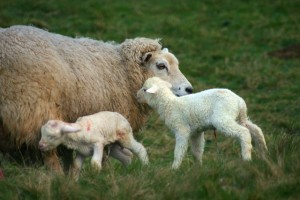Sheep Diseases
Magnesium Deficiency in Sheep
Also known as: Grass Staggers, Hypomagnesaemia
Sheep need a continuous supply of magnesium as they cannot store it and yet it is an essential element that is involved in many energy-generating reactions in their tissues. It is also required to maintain the normal transmission of nerve pulses. Deficiency, or hypomagnesaemia, is most common 4 to 6 weeks after lambing when deficient animals show very characteristic symptoms including uncoordinated walking, trembling or recumbency.

Magnesium deficiency is most common 4 to 6 weeks after lambing when deficient animals show very characteristic symptoms including uncoordinated walking, trembling or recumbency
Sheep have very small reserves of magnesium to buffer changes in absorption of magnesium. Seventy percent of this magnesium is relatively tightly bound in the skeleton and can only be released during general bone resorption. However, bone turnover decreases in adult animals. There is evidence that a large proportion of the magnesium absorbed is sequestrated by adipose tissue, and that this is increased during periods of stress, predisposing hypomagnesaemia (Caple, 1989).
Clinical Signs of Hypomagnesaemia
The clinical signs of magnesium deficiency are dramatic. Ewes affected by magnesium deficiency are often either unable to walk or appear uncoordinated. They will often collapse and become sensitive to touch. They frequently show trembling, and when they are stressed they will rapidly become recumbent with legs extended and exhibit involuntary contraction of muscle (tetanic spasms). If they are not treated immediately, death follows rapidly (EBLEX 2008).
Risk factors
There are several factors affecting magnesium absorption in the rumen. There is an increased risk of hypomagnesaemia in ruminants when they are grazing on pastures rich in potassium (Schonewille et al., 1999). Both potassium and rapidly degradable protein have a negative effect on magnesium absorption, as has a high rumen pH. The coincidence, therefore, of high dietary intake of potassium and degradable protein in rapidly growing spring herbage means that conditions for magnesium absorption are critical at this stage (Dalley et al., 1997; Leonhard-Marek et al., 1998). Magnesium levels are often low in rapidly growing spring grass. Cold exposure may also predispose ewes to hypomagnesaemia (Terashima et al., 1982).
Control and Prevention
Sheep rely on absorption of magnesium from the rumen to meet most of their needs. The animal cannot modify magnesium absorption and absorbs only a small proportion of the magnesium consumed.
High potassium and protein levels, both of which contribute to magnesium deficiency, are less common under extensive pasture based management systems. The inclusion of legumes in the pasture, which contain a higher level of magnesium than grass, should be something that needs to be considered when running a pasture based system. There are grass varieties that have been bred for high magnesium content (Binnie et al., 1996; Crawford et al., 1998; Hemingway, 1999; Moseley and Baker, 1991) that may be considered for incorporation within grass sward mixtures.
Given that potassium has an antagonistic role in magnesium deficiency, it has been recommended that the potassium content of grass in the spring should not exceed 2.5% (EBLEX, 2008). Introducing animals gradually and early in the spring can reduce the risk.
Supplementing sheep and cattle with potassium bicarbonate decreases magnesium absorption although the same effect is not seen with all potassium salts (Schonewille et al., 1999).
Treatment
Treatment of clinical cases involves the subcutaneous administration of Magnesium hypophosphite, or the intravenous administration of a combined solution of calcium and magnesium. However, only a very small volume may be given intravenously, and only in combination with calcium. Please consult your veterinarian. Clinical signs of hypomagnesaemic tetany in sheep occur when hypomagnesaemia (plasma tMg <0.5 mg/dL [0.2 mmol/L]) occurs concomitantly with hypocalcaemia (plasma tCa <8 mg/dL [2.0 mmol/L]). The disease in lactating ewes occurs under essentially the same conditions and has the same clinical signs as in cattle.
For more information on Control, Prevention and Treatment, visit the Magnesium Deficiency in Cattle pages.
Good Practice Based on Current Knowledge
- Use plants in the sward (e.g. legumes) containing a higher level of minerals, including magnesium
- Avoid high potassium levels in the sward – care should be taken with cattle slurry and chicken manure
- Avoid long periods of fasting, especially for lactating cows
- The potassium content of grass in the spring should not exceed 2.5%
- During high risk periods, introduce animals earlier and gradually
- On farms where lactation tetany is a problem, dressing the pasture with kieserite may be a long-term solution
- To prevent further cases of lactation tetany the flock should be moved off the danger area and onto some permanent pasture or longer-term ley
- Supplement the affected group with magnesium oxide (magnesite) (120 g/day), magnesium phosphate (54 g/day) and epsom salts (MgSO4)


 American English
American English

Comments are closed.